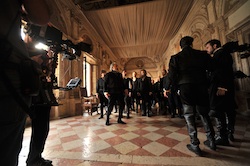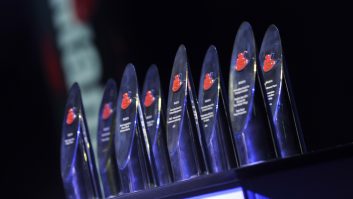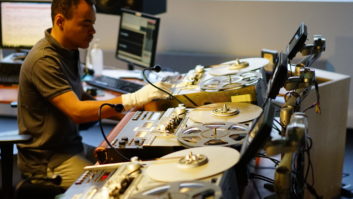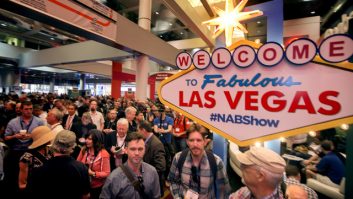
At the beginning of September, Italian state broadcaster Rai and Andrea Anderman’s Rada Film produced a ‘live film’ of Rigoletto in Mantua, the town in which the Verdi masterpiece is set. Mike Clark reports on how it all came together.
The event – which aired in 138 countries and is scheduled for DVD release – was directed by Marco Bellocchio with cinematography by triple Oscar winner Vittorio Storaro. It starred Placido Domingo in the role of the Duke of Mantua’s court jester.
As well as the spectacular original locations of the beautiful lakeside Renaissance town of Mantua in which the solo singers, chorus and dancers moved a great deal — respecting the time of day in the opera’s libretto — the Rigoletto production was unique due to the behind-the-scenes aspects that made it so difficult to pull off successfully. These included the fact that Rai’s 62-piece National Symphonic Orchestra (conducted by Zubin Mehta) played in the town’s Bibiena Theatre, while the action took place in three sets in other parts of the town.
Two-way video and audio monitoring with built-in redundancy was therefore essential, to enable Mehta and the orchestra to hear (and see) the singers and vice versa, and the risk of signal delay had to be seriously addressed (this was eventually reduced to an acceptable 1.4 msec).
Director Marco Bellocchio’s introspective handling of the opera, compared to that of the previous two productions (Tosca in Rome and La Traviata in Paris, both directed by the late Giuseppe Patroni Griffi) featured a lot of close-ups, meaning hard-wired mics, loudspeakers and video monitors had to be out of the cameras’ sightlines.
As Rai production manager Claudio Fizzardi explains, “We had three HD production units at the event. Two were our Milan HD OB vans, the Esterno 1 artic and our new three-axle Esterno 2, coordinated by Luca Latini and Alessandro Resasco respectively. We also had another OB production set-up in flight cases at the theatre, with four broadcast cameras dedicated to the orchestra and conductor, plus a single fixed camera on Mehta, enabling his directions to be followed on the various sets.
“The signals of the coverage of the conductor were transported via fibre optics, with a back-up channel transmitted via radio,” says Fizzardi. “Installing dedicated fibre optics for the event would have been out of the question, so we rented two fibres in the town’s network and connected our equipment to them, then from the node at the theatre the signals were forwarded to the sets – Palazzo Ducale, Palazzo Te and Rocca di Sparafucile. In the last one we had to install everything from scratch, as there weren’t even telephone lines!”
Integrated production
Since the locations were classified monuments (open to the public when rehearsals were not under way), cable runs were another problematic aspect — as explained by Fiervisaggio Giorgetti, a member of the engineering team led by Claudio Conti from Radio Rai (responsible for the opera’s broadcast audio) that installed the complex audio network: “At Palazzo Te, for example, every evening after rehearsals we had to disconnect all the cables passing through the windows and reconnect them all the next morning. At Palazzo Ducale, the cables had to be run across the garden and up to the upper floors and at Rocca di Sparafucile our cables were run through the trees’ branches, otherwise there was a risk of visitors damaging the fibre optics.”
For this production, the two vans’ crews formed one large 50-man team and cameras were all Grass Valley LDK 8000 (or 8000 Elite). The number used varied from six in Act 2 (including two steadicams and two dollies) to fifteen in Act 1, including two steadicams, five dollies and a 9-metre track-mounted crane with a remote head. The steadicams were connected to the OB vans via triax cable, not via radio (to ensure sync).
HD Coordinator Alessandro Resasco says, “our newer 12-metre van is based on an IVECO Stralis 260/420 truck with hydraulic expansion and a twin air conditioning set-up, which keeps ops cool as they use the cutting edge on-board hardware. This includes a Sony MVS 8000 production switcher with 80 primary inputs, a Grass Valley Trinix 256×256 router, four Sony XDCAM HD units, two EVS XT[2]+ HD production servers and more.
Luca Latini adds, “While maintaining the same high equipment standards, the two vans’ differences include their dimensions (Esterno 1 is larger and has a room dedicated to VTRs and their control), the Panasonic BT-LH1760 production room monitors (32 and 28), the Stagetec Aurus digital audio console (40 and 32-fader versions) and the fact that Esterno 1 also has four LDK6200 HD Super SloMo cameras.”
The OB vans’ audio engineers received a main and back-up stereo feed from Radio Rai’s audio control rooms on the sets. RAI Radio’s audio project chief Tony Ciano says, “each of the three sets’ control rooms has a Yamaha MC7L desk used to mix the solo singers, which sends a feed to a Yamaha DM2000, used to mix it with the chorus, other effects from the sets and a mix-down of orchestra sound, received from the theatre. The DM2OOO then forwarded this final mix to the truck.”
For BBC’s on-site presentation of the three acts by Katie Derham, SIS Live provided a small integrated uplink and production facilities. SIS Technical Manager Andrew Bracewell says, “because of the BBC transmission slot, we had to slightly delay the opera, as it started shortly before we came to it. So we used an EVS unit to record the opera and play it out again a few seconds later. Our producer was Peter Maniura, head of BBC Television Classical Music & Performance, who doubled as our director at the event.”
After the event, Bracewell enthused, “It was one of the most unbelievable events I’ve ever seen — and I’ve been to some major events. It was just fantastic the way they made it all work!”







